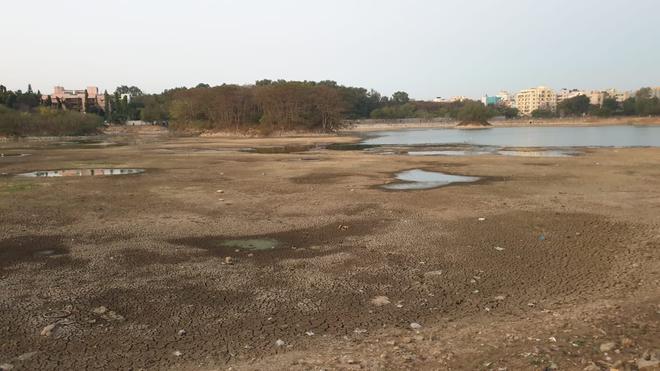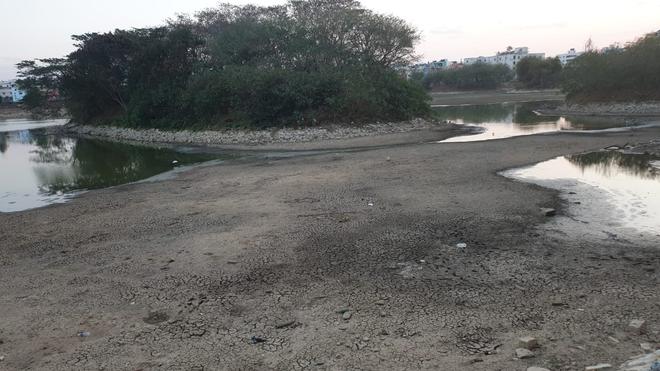Lakes drying up as the scorching summer heat intensifies. Should this spreading spectacle be a cause for worry or an opportunity for Bengalureans? Reminding that the city’s lakes were never perennially filled right through the year, environmentalists instead see the next two months as critical to de-silt and de-sludge the water bodies, a sure-shot way to keep them alive.
To address the city’s mounting summer-time drinking water demands, lakes were seen as potential storage tanks. But the accumulation of sewage and silt over decades have made most lakes unthinkable as complementing the piped Cauvery water. So, is increasing the capacity of lakes the best option? It is complicated, lake experts say.
Flat lakebed depth, a no-no
Increasing the depth of lake beds uniformly with only capacity upgrade as objective is not the way to go, notes Raghavendra B. Pachhapur, Senior Project Lead with ActionAid Association, a non-government institution. Lake rejuvenation is not only about removal of residual silt but also about building a habitat around the water bodies for birds and wildlife to thrive, he explains.
The foreshore area is where water enters a lake from multiple streams and the rajakaluve. He reminds, “That area will be naturally shallow. The depth increases towards the other end of a lake at the bund region to a maximum of 10-12 ft. This was the usual conservatory lake. But now, they are building bunds around the lake for people to walk, and this means almost a uniform increase in depth.”
This design, dubbed as ‘soup bowl’ to help increase water capacity and suit fisheries, is inevitably hostile to migratory birds that usually flock to shallow areas within a lake. But has the capacity really increased in rejuvenated lakes and in what manner?

Alarming fecal coliform
Lake water quality monitored by the Karnataka State Pollution Control Board (KSPCB) shows an alarming rise in Fecal Coliform (measured as Most Probable Number (MPN)/100ml) in most city lakes. Fecal Coliform is a bacteria found in human faeces, confirming that the inflow of untreated sewage into lakes is still extremely high.
The National Greens Tribunal (NGT) has mandated that the Fecal Coliform in water flowing out of the Sewage Treatment Plants (STPs) into the lakes should not exceed 230 MPN/100ml, with the desirable at an even lower standard of 100 MPN/100ml. Within lakes, it is expected to be within 300 to 500 MPN / 100ml. But the reality is a different story.
In Ulsoor lake, categorised as ‘D’ by KSPCB for fish breeding, the Fecal Coliform is 4,000 MPN / 100ml. But this pales in comparison with 92,000 in Herohalli lake, 40,000 in Varthur lake, 79,000 in Kaikondrahalli Lake and 79,000 in Puttenahalli lake. These are December 2023 figures published by the KSPCB.
Inevitably, this would seem to puncture claims that many rejuvenated lakes now have water. Raghavendra points out that the Bruhat Bengaluru Mahanagara Palike (BBMP) feels the civic body is happy when water is seen all through the year. “But the Palike never thinks of what sort of water is entering the lake and the groundwater,” he notes.

Flawed dissolved oxygen tracking
Dissolved Oxygen (DO) is another critical measure of lake water quality. Sample test results put out by KSPCB show surprisingly good results. A majority of lakes have DO levels within the permissible 5 mg/L. But scientists and lake experts have questioned these results, since they do not follow the Dawn/ Dusk method.
Simply put, the water samples have to be tested before dawn or after dusk to get a correct measure. During day time with sunlight, plants and organisms take oxygen from the surface and thus the DO levels remain high. The samples are collected and tested during day time, giving high values. But night time OD could drop dramatically. Fishkill is a clear symptom of this phenomenon.
Ramprasad V., Founder, Friends of Lakes (FoL) finds the ‘grab sampling’ methodology currently being followed as flawed. “At 12 noon, OD will obviously be very high due to photosynthesis and other things going on in the lake. Do it at 11 pm. We had done a testing in Ulsoor Lake at 11 pm. By 1 A.M., the dissolved oxygen levels had dropped to zero. There are high chances that it could lead to fish-kill. At 11 A.M, the OD read 6-7. We need to push for a legal sampling,” he explains.
Not perennial lakes
Corrective measures can happen when the lakes go dry, says Ramprasad. “And, Bengaluru lakes drying during summer season is a very normal thing. None of these lakes are perennial, they are all seasonal lakes. If urban dwellers are crying that the lake is dry, then they don’t know Bengaluru lakes. We are 100% opposed to this urban elitist mentality that lakes should have water 24/7, 365 days, and should be fully filled. That imagination is really wrong, because you need some time to de-sludge.”
De-sludging, the process of taking out decayed organic matter due to sewage inflow, provides good manure that can be taken to any farmland. “Varthur lake has done it. About 350-400 farmers are using that manure. This was a very traditional method of maintaining a lake. But it has now taken a bad beating due to chemical farming. This tradition saw to it that lakes had enough water, while at the same time the land got its nutrients from the same soil. It was a sustainability cycle,” he recalls.
Different functionalities
However, not every lake needs this treatment. “Every lake need not be the same. Some can be shallow to maintain the biodiversity, and there can be some others deep enough to hold enough water and aid groundwater recharge. Different lakes can have different functionalities. Painting everything with the same brush is not right.”
Yet, the functionality and purpose of a lake to be either for rainwater harvesting or as a recharging structure is not clearly defined. This, says Ramprasad, does not figure in any of the Detailed Project Reports (DPRs) for lake rejuvenation. Lakes, he is convinced, should be scientifically rejuvenated based on the topology and hydrological characteristics of the water bodies.
This lack of clarity is evident even in Bellandur and Varthur lakes, he says. “They claim they have dredged the lake. Is there a spatial analysis done to show the increase in depth to their original water-holding capacity? Are these lakes aiding in the percolation of water for groundwater recharge?”
The Lingadheeranahalli lake on the city’s outskirts near NICE road might be a telling example of the rejuvenation exercise going wrong. As Raghavendra recalls, this was a nesting place for birds, a reflection of the comfort level the avian species had in the ecosystem. “On the lake’s foreshore, a big patch of land is now being cleared for rejuvenation. They say they will have new plants there. But it will take another 15 years for those plants to come back. There is no use, they have destroyed it.”







